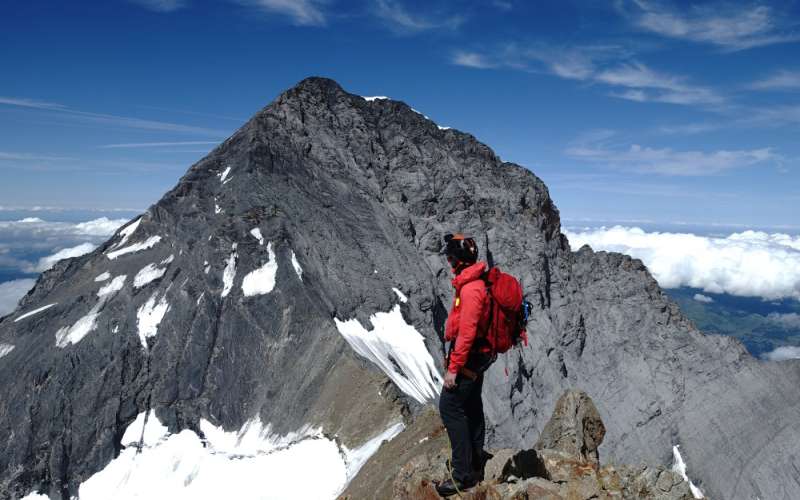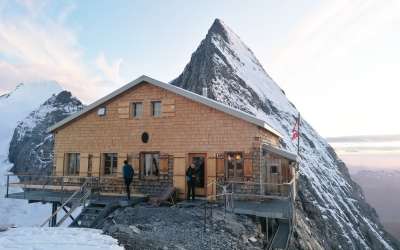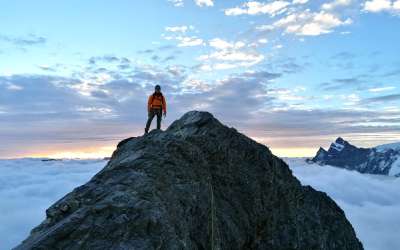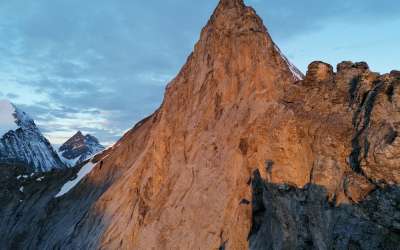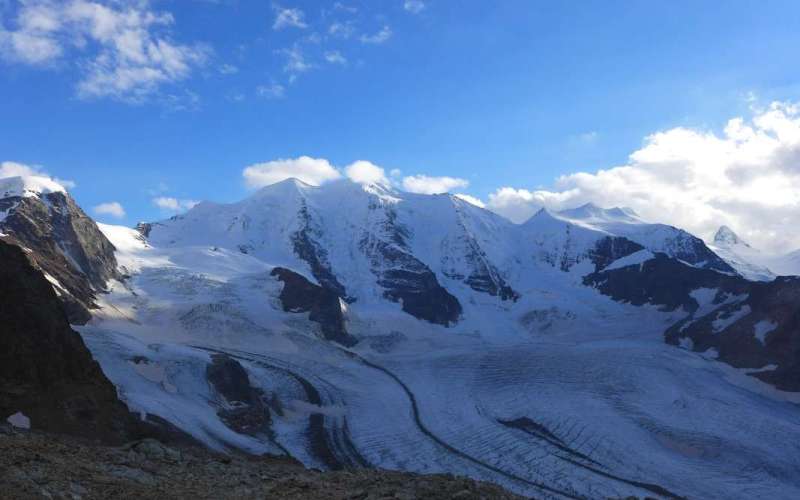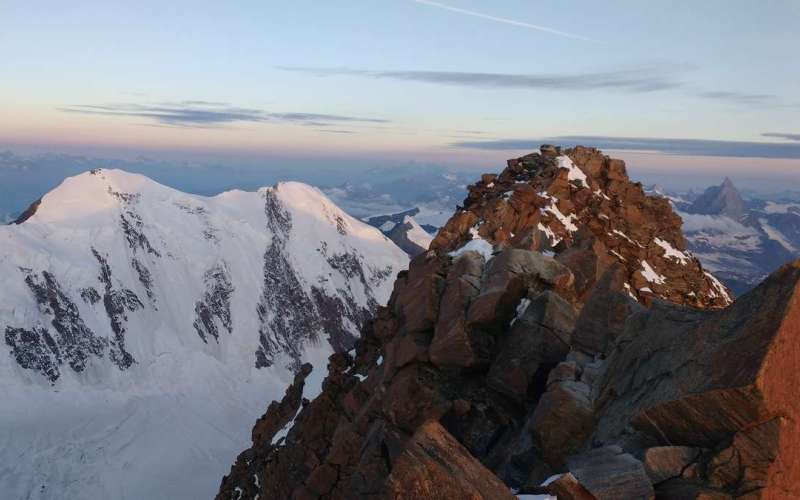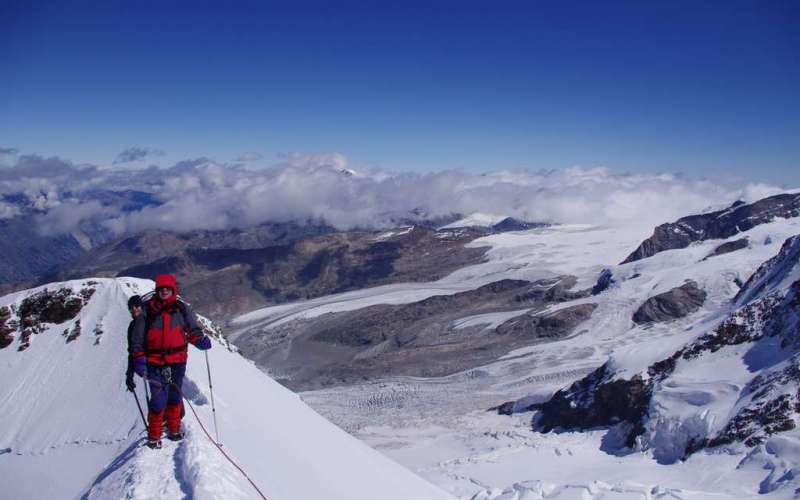Eiger Mittellegi Ridge
The Eiger is probably the best-known almost 4000-metre peak in the Alps and the only one that is mentioned in the same breath as the great names Matterhorn, Mont Blanc and Weisshorn. The fascination of the Eiger can best be described as eerily beautiful: there is hardly any other mountain face that looms as menacingly as the Eiger North Face above Grindelwald. This gigantic face with its dramatic climbing history shares the reputation of being the most difficult with the Jorasses North Face and is still the scene for high-end alpinism today.
If you look at the Eiger from the east, it reveals a quite unexpectedly slender shape. Where the gloomy north face and the rocky south face touch, the knife-edge Mittellegi Ridge soars into the sky. This ridge is neither an insider tip nor a remote adventure route. Nevertheless, the atmosphere is different to other trendy summits - you'll rather feel like an alpinist among his peers. This is not only due to the limited capacity of the small and welcoming Mittellegi Hut. Furthermore, the Mittellegi Ridge is a route that requires excellent climbing skills and a lot of experience and routine in the full set of alpine belaying techniques. Although there are a lot of fixed ropes in place the route should not be underestimated: the rock is often slopy and brittle and the belay points in the upper third are very poor. After the summit the lengthy descent via the Eigerjöcher requires full attention. All in all, this is a route for experienced climbers only and should be on top of the tick list of every achieved alpinist.
Itinerary
Day 1: We meet in the morning for a kit check and pre trip briefing. Once our light packs are ready, we take the new gondola and continue with the Jungfraujoch Bahn to the Eismeer station at 3100m. Through a tunnel we enter the upper Eismeer glacier.Having crossed some big crevasses, we embark on the easy but very exposed traverse to the Mittellegi Hut. Route finding there is very tricky. The first rocky crux of the route, a slabby limestone pitch graded VD 5.4 waits at the transition from glacier to rock. After about 2 hours we reach the hut, which clings to the narrow ridge like an eagle's nest. ↑ 400m ↓ 100m 2hrs climbing
Day 2: At daybreak, we start on the horizontal ridge. As the ridge steepens we reach the first steps climbed free or partly on fixed ropes. The tips of the boots have to be placed precisely on the slopy limestone. Commonly after the Big Tower we switch to crampons, since the route slants right into the northeast face for three pitches. The exposure becomes breathtaking with more than a mile of air between our frontpoints and the green pastures of Alpiglen. The ridge now leans back, but is by no means easier. Tricky rock sections alternate with sharp firn ridges. After about 4 hours we reach the pointy summit. An equally long descent now awaits us - first on abseils, then across beautiful and airy climbing sections on gneiss. A final firn ridge and finally we cross under the Mönch Eastface to the Mönchsjoch and back to civilisation. ↑ 1000m ↓ 700m 9hrs climbing
Prerequisites
- excellent physical fitness: stamina for 10-hour alpine days;
- technical skills: confidence to quickly second in the French grade 3c in mountain boots or 4c in rock climbing shoes (US 5.4 to 5.6, UK VD to HS)
- to give you an idea the ridge is technically harder than the Hörnligrat on Matterhorn.
Accommodation & Food
We will stay in a small alpine mountain hut with a common dining room and dormitories with usually 4 – 12 bunks. The sanitary conditions are basic with common toilets, washing rooms. Depending on the time of year, there's not even running water.
We typically have half board on the hut. A lean breakfast with bread, jam, butter and sometimes cereals are served along with coffee or tea. Dinner consists of 3 to 4 courses: starter, maybe salad, main course with some meat, desert. Vegetarian or other dietary requirements are accounted for.
Gear
Full glacier travel kit. Alpine climbing kit.
Included
- Organization and guiding by a IFMGA licensed Mountain Guide
- Rental gear if needed
- All guide's expenses
Excluded
- 1 x Night/Half board in a mountain hut approx. 90 CHF/Night
- Lunch and drinks at the huts. (Lunch for take away can be ordered the day before)
- lift ticket 220 CHF
- personal insurance covering mountain rescue
Specials
for this trip
Flexibility: joint risk of bad (weather) conditions.
Flexibility is our working method - not a slick marketing slogan. We budget 1-2 extra days in the planning of many of our trips to factor in adverse weather conditions. The days can for example be used to move the trip a day or two as to use the best weather window for the summit bid.
Of course you only pay the actual guiding days. We'd rather achieve your goal than insist on doing a poor alternative.
Alternate dates: if it doesn't work out first try.
Ambitious alpine goals require the right conditions and this might not be the case on your first try. We understand that you don't want to hire a guide for not climbing your cherished dream route. On our individually arranged trips we discuss and agree on how to deal with this situation prior to the trip.
Understandably we cannot cancel all our trips in the high season. But we will come up with a fair deal for both sides: a prefixed alternate date, a voucher for the next attempt, an adapted rate for smaller and less committing objectives, or the option to cut off some days.
Bivies, acyclic and unknown paths: off the beaten track.
The Alps are the Playground of Europe and Europe is densely populated. Some areas are frequented to a degree that is almost grotesque. Traffic jams, risky overtaking maneuvers and utter chaos on lifts and huts are common sight. Clearly the experience must be suffering.
Clever planning can avoid this and the mountains can be experienced in a pristine way — even on big and renowned peaks. We have a long record of guiding some of the most prestigious summits using bivies and less known routes, or simply climbing acyclic. It has always paid off! Does this sound appealing to you? Let's discuss your next true adventure in the mountains!







